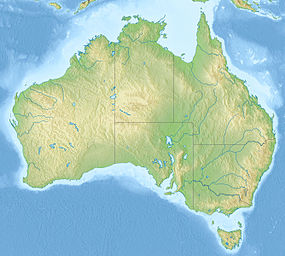
Back نهر سنوى ARZ Сноуи Ривър Bulgarian Snowy River (suba sa Ostralya, State of New South Wales, lat -37,80, long 148,53) CEB Sněžná řeka Czech Сноуи-Ривер (юханшыв) CV Snowy River (Bass-Straße) German Río Snowy Spanish Snowy Finnish Snowy River French სნოუი (მდინარე) KA
| Snowy | |
|---|---|
 The Snowy River at Kosciusko Summit Walk. | |
Location of the mouth of the river in Australia | |
| Etymology | Named by John Lhotsky in 1834[1][2] |
| Nickname(s) | The Snowy |
| Location | |
| Country | Australia |
| States | New South Wales, Victoria |
| Region | South-east Australia |
| Towns | Jindabyne (NSW), Orbost (Vic), Marlo (Vic) |
| Physical characteristics | |
| Source | Australian Alps, Great Dividing Range |
| • location | below Mount Stilwell, New South Wales |
| • elevation | 2,200 m (7,200 ft) |
| Mouth | Bass Strait |
• location | Marlo, Victoria |
• coordinates | 37°47′S 148°31′E / 37.783°S 148.517°E |
• elevation | 0 m (0 ft) |
| Length | 352 km (219 mi) |
| Basin size | 15,779 km2 (6,092 sq mi)[3] |
| Discharge | |
| • location | mouth |
| • average | 75 m3/s (2,400 GL/a)[3] |
| Basin features | |
| River system | Snowy River |
| Tributaries | |
| • left | Moonbah River, Maclaughlin River, Jacobs River, Deddick River, Rodger River |
| • right | Delegate River, Wullwye Creek, Pinch River, Suggan Buggan River, Buchan River, Brodribb River |
| Waterfalls | Stone Bridge, Corrowong, Snowy, and Pinch |
| National parks | Kosciuszko NP, Alpine NP, Snowy River NP |
| [4] | |
The Snowy River is a major river in south-eastern Australia. It originates on the slopes of Mount Kosciuszko, Australia's highest mainland peak, draining the eastern slopes of the Snowy Mountains in New South Wales, before flowing through the Alpine National Park and the Snowy River National Park in Victoria and emptying into Bass Strait.
While the river's course and surroundings have remained almost entirely unchanged, the majority of it being protected by the Snowy River National Park, its flow was drastically reduced in the mid 20th century, to less than 1% (as measured at Jindabyne), after the construction of four large dams (Guthega, Island Bend, Eucumbene, and Jindabyne) and many smaller diversion structures in its headwaters in New South Wales, as part of the Snowy Mountains Scheme.
The river has been immortalised in cultural folklore through the poem The Man from Snowy River, written by Banjo Paterson in 1890, which formed the basis of many subsequent works in film, TV and music theatre.
- ^ Feeken, Erwin H. J.; Feeken, Gerda E. E. (1970), The discovery and exploration of Australia, Melbourne: Nelson, p. 318, ISBN 0-17-001812-1, cited in Bird (2006)
- ^ Bird, Eric (12 October 2006). "Place Names on the Coast of Victoria" (PDF). The Australian National Placename Survey (ANPS). Archived from the original (PDF) on 18 February 2011.
- ^ a b "East Coastal Watersheds".
- ^ "Map of Snowy River". Bonzle Digital Atlas of Australia. Retrieved 2 June 2013.
